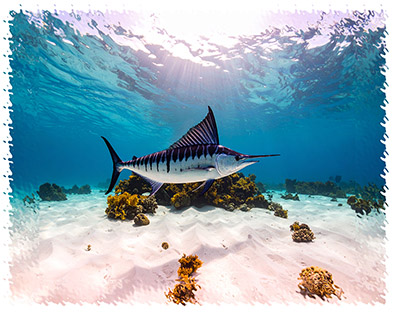

This beautiful blue marlin is made by Cabin Critters.
The Blue Marlin, Makaira nigricans ampla, resem bles the swordfish, but can readily be distinguised by its rounded spear, by its dorsal fin which extends much further along the back and which can be depressed, fitting into a groove in the skin, and by the presence of pelvic fins and peculiar thorn-like scales, both of which are absent in the swordfish. The shining, dark-blue back and silvery belly of the blue marlin make it one of the most beautiful of all of the big-game fishes. Its powerful, yet streamlined, body is a delight to the artists as well as to the sportsman. It is among the fastest marine swimmers.
The blue marlin occurs in the Atlantic Ocean and is found from Florida and the West Indies to Montauk Point, on the tip of Long Island, New York. There is another Atlantic species, the White marlin, Makaira albida, that is much smaller, its maximum size being about half that of the average size of the blue marlin. The blue marlin averages about two hundred pounds. One twelve-hundred pound giant has been recorded as caught in a net by Cuban fishermen. The record rod-and-reel catch weighed 742 pounds and was twelve feel, ten and one-half inches long. In the Pacific, there are probably three species of marlin, the Striped Marlin, Makaira mitsukuri, being the one seen off southern California. The Black Marlin, Makaira nigricans marlina, found from Peru to New Zealand, may reach a length of fifteen feet and a weight of 1,226 pounds. It is the largest member of the group.
All of the marlins are much-sought-after game fishes. The thrill of having one of these fighting, swift-running, plunging, tail-dancing fish on the end of a line is perhaps the greatest in all sports fishing.
We know very little about the life history of any of the marlins. They all feed on fish and squid. Sometimes they occur in numbers, but more often they are solitary. They are at times found in pairs, spawning of the blue marlin is that most probably there are breeding grounds off Cuba and that reproduction occurs during the summer and early fall. The marlin family (Istiophoridae or "sail-bearers") contains about two different fishes, among them the spearfish and the sailfishes.
All dwell in tropical and warm-temperate seas. The Atlantic Blue Marlin and the White marlin are endangered due to overfishing.Kingdom: Animalia | Phylum: Chordata | Class: Actinopterygii | Order: Istiophoriformes | Family: Istiophoridae
The Marlin stuffed animal shown here is made by Cabin Critters. Find it at our sponsor's online gift shop.
Class: Actinopterygii | Order: Perciformes | Family: Istiophoridae




